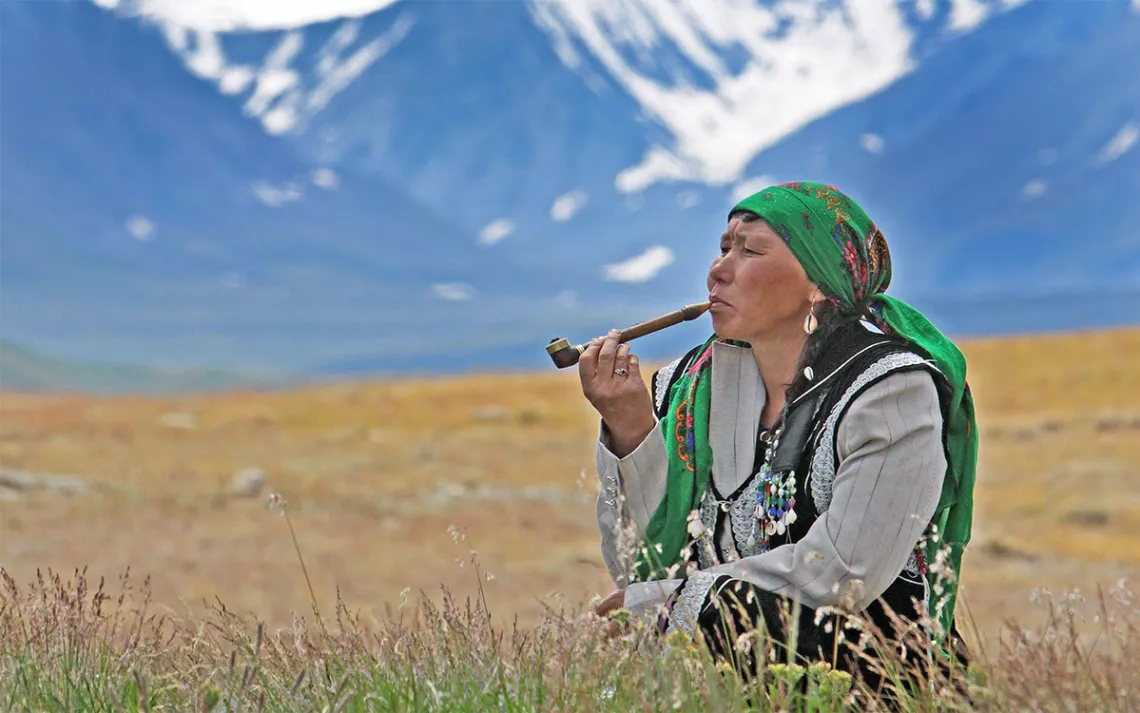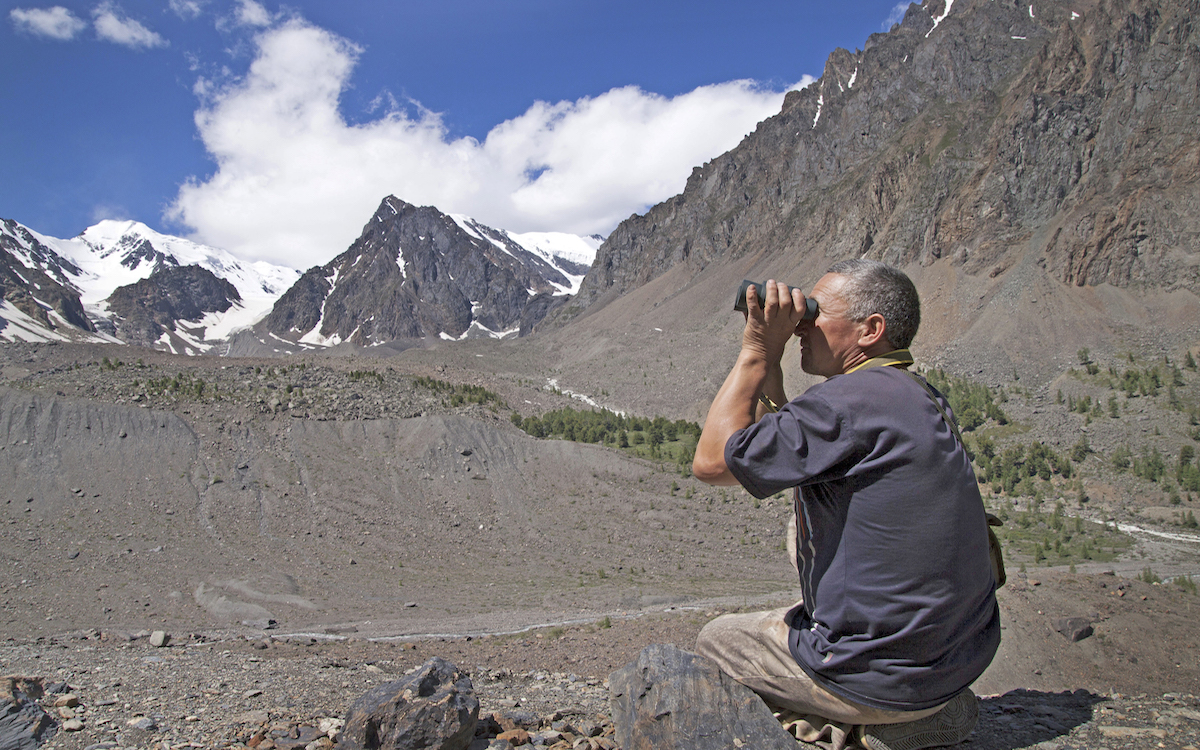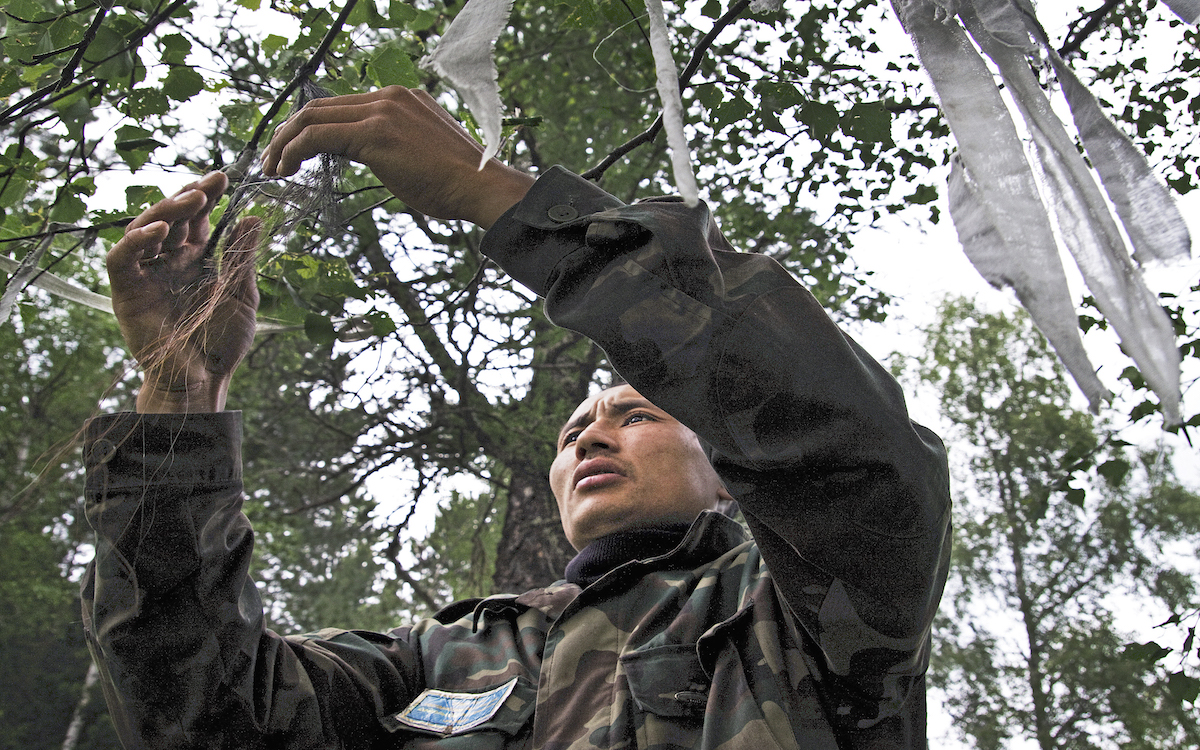Lament for Aktru
A writer journeys to the Altai Mountains to investigate climate change

Maria Amanchina, a traditional Altai shaman and healer, lights a pipe to send her prayers to the Sky, the Land, and the Spirit of Altai. | Photos courtesy of Gleb Raygorodetsky
Reprinted from The Archipelago of Hope by Gleb Raygorodetsky, published by Pegasus Books, Gleb Raygorodetsky. Excerpted with permission from the publisher. All other rights reserved.
The Kurai steppe lies between the snow-capped mountain peaks of Russia’s Altai Mountains to the south and the rolling plains of Mongolia to the east. A five-mile-long, bumpy road leads from the tiny village of Kurai—a few dozen wooden houses clustered at the foothills—to the Aktru glacier, 50 miles from Russia’s border with Mongolia. I am traveling to Aktru to learn about the impact of glacial melt on the lives of local people.
Mountain regions make up more than a quarter of the planet’s surface, providing homes for more than a billion people. The mountains harvest water from the atmosphere and store it in snowpack, glaciers, and permafrost. Released from the mountains in the spring, water flows to the lowlands, sustaining rich biodiversity and supporting agriculture. Because of their height, slope, and exposure, mountain ecosystems are more sensitive to climate change than valleys and plains at low elevations. As the air warms, mountain ecosystems are changing, with cold-tolerant alpine plants marching up the slope, as the brush and trees, adapted to the warmer climates, move in. This is happening at the same time as mountain glaciers are retreating and permafrost is melting.
Earth’s cryosphere—places on our planet where water exists in solid state, such as mountain glaciers, Arctic permafrost, and the Antarctic ice fields in the southern hemisphere—has been diminishing at unprecedented rates. Normally, the glacial ice is maintained through a dynamic equilibrium between snowfall and snowmelt in the mountains. As the temperatures rise, the scale tips more and more toward the thaw, causing the glaciers to disappear faster than they can be replaced by the winter snow. Over the last century, the European Alps have lost up to 40 percent of their ice, New Zealand, 25 percent, and Africa’s Mount Kenya and Mount Kilimanjaro as much as 60 percent. According to the latest Intergovernmental Panel on Climate Change (IPCC) assessment report—the most authoritative and influential reference on global trends of climate change published every seven years—the average rate of ice loss from glaciers around the world between 1971 and 2001 was close to 226 gigatons (billion tons) per year. And over the first decade of the new millennium, that rate of ice melt has accelerated by about 15 percent. In weight, this is equivalent to 43,000 Great (Ice) Pyramids of Giza thawing every year. Such loss of glaciers increases the likelihood of catastrophic floods and erosion, and foreshadows a rise in sea level, as the increased glacial melt reaches the ocean.
But glaciers are not just isolated slabs of ice in the inaccessible reaches of anonymous mountain ranges. They are an integral part of the local socioecological systems. Through the ages, glacial advances and retreats have not only carved the landscapes but also shaped the evolution of human societies by raising and lowering sea levels, covering and opening areas suitable for human habitation, and providing water for drinking and irrigation in otherwise inhospitable environments. Though invaluable as a source of robust scientific data, the IPCC and other scientific reports are not very helpful in conveying the true nature of climate change impacts at the local, community scale. The only way to develop such an understanding is by learning from local people who have lived with the changing conditions in the mountains for decades. I searched for this understanding among the local people of Russian Altai.
I stop for the night at Oleg Boltokov’s zelenyi dom, Russian for “green house,” as locals call this type of hostel—the only place for weary travelers to spend the night and grab a bite on their way to Aktru glacier. Our dinner is served outside, on a long communal table next to the kitchen. Oleg has just returned from taking a group of tourists to the glacier and, over dinner, we talk about climate change. Born and raised in Kurai, Oleg is in his early 40s and still remembers how, when he was little, there used to be one massive Aktru glacier. As the ice melted, the glacier split into two separate tongues, now almost half a mile apart. As I learn later, the number of Altai glaciers has increased by 25 percent since the 1970s, because the massive ice shield of old split into smaller segments as the ice melted. At the same time, the amount of ice locked in these glaciers decreased by about a quarter over the same period.
“Certainly climate is changing,” Oleg says with the same conviction of an eyewitness I have heard from different Indigenous peoples I have talked to while working on the book The Archipelago of Hope. “In the past, everybody knew when winter was coming and what to expect during the spring. We could predict what the weather would be like and plan when and where to move our cattle and sheep. That’s getting much harder to do now.” Oleg describes how last winter came early, but it was mild and with little snow. As a result, the spring pastures remained dry, which made it hard for locals to keep their cattle healthy. Strong winds used to be uncommon, but over the last few years they have been getting stronger, more frequent, and less predictable. In many places, the strong winds hardened the snow, making it difficult for the cattle to move around and find grass.
“The rains are now short, but they come down very hard,” Oleg continues, comparing the recent downpours to the prolonged drizzles common in the past. “Still, for the last three years it was very dry, the grass burned, and there was nothing for the cattle to eat. We kept our sheep for food, but had to sell all of the cattle.” Maybe it is because there is less ice in the mountains now, muses Oleg, though different people have different opinions about this. Some even blame it on the rockets being launched into space from the Baikonur in neighboring Kazakhstan. But most locals, especially elders, talk about the poor attitude that people now have toward nature as the root cause of all our environmental troubles.
The Aktru glacier is the most accessible glacier in southern Siberia, Oleg explains, and, in July, tourists can easily walk up to it. Many come from different parts of Russia, drawn by the “untouched wilderness” and a bit of local culture. Oleg himself hosted more than 300 people last year. But the 13,200-foot-tall Aktru Mountain, which gives birth to the Aktru glacier, is a sacred site for the local people, and the tourists coming here do not behave in a respectful way, Oleg grumbles. They booze, climb all over the place, and make a racket, showing little regard for local people and their traditions. More troublesome is their lack of respect for the spirits, or “bosses,” of these sacred places, says Oleg. In addition to the physical impact, the visitors’ insolence leaves a heavy spiritual imprint on the land. When they leave, it is the local people who must deal with the consequences of their actions. This includes local shamans carrying out traditional ceremonies to restore the balance between local people, the glaciers, the mountains, and Altai. Ultimately, Oleg concludes, climate change is a symptom of people’s ignorant actions upsetting the natural balance of life on Earth.
In the Altai traditional worldview, all natural things—whether plants or planets, bees or boulders, spiders or spirits—are recognized as conscious living beings, endowed with all the functions, feelings, and follies of a person. For Oleg and his kin, Altai is a breathing and sensuous living entity, with which they must keep their relationship in balance if they want to have a good life. If nature is not treated with reverence, reciprocity, respect, and restraint, the relationship becomes compromised, leading to environmental imbalance, such as climate change. Altai people support this relationship through cultural practices and ceremonies that restore and maintain their bonds with local animals and plants, sacred mountains and springs, wind and water. Traditional rituals have always been conducted throughout Altai, even during the repressive Soviet epoch. Each village has an ancient altar that has been used for such ceremonies for generations. To this day, ancestral Altai clans preserve and pass on the lore of their intimate relationships with totem animals and plants, sacred mountains and lakes, their ancestors and spirits.

Above: Alexander Dibesov, a warden of a mountaineering camp, scans the scree slopes for signs of mountain sheep around the Aktru glacier. Just 60 years ago, the glacier came down all the way to where Alexander is kneeling. Today, it is barely visible up the slope in the distance.
Below: En route to Aru-Kem Lake in the Uch-Enmek Nature Park, Uchural Nonov, a park warden, ties a kyira of horse hair to a sacred tree.

Indigenous peoples, as well as scientists, recognize, however, that Earth’s self-regulation is not limitless. If certain conditions within the system change too significantly, or rapidly, the system can pass a tipping point and flip into a new, potentially irreversible, state a lot less supportive of human well-being. According to these insights, climate change is an indicator of the Earth’s affliction, a warning that our planet’s life-sustaining prowess is being compromised.
The next morning, we leave Oleg’s place and head for Aktru. The road snakes along the fields and pastures, past some ancient kurgans. Hugging the undulating foothills, it gains in elevation and turns rougher as we climb. Every tree root and boulder along the way threatens to break our axle in half or throw us from the vehicle. Eventually, we enter the pine forest, which quickly transitions into alpine meadows. Finally, we are crossing moraines—ridges of gravel and rocks deposited by melting glaciers—furrowed by glacial streams.
At the mountaineering camp near the Aktru glacier, we meet Oleg’s friend Alexander Dibesov, a warden and my guide for the day. From the camp, we follow a narrow foot pass snaking among giant boulders to the crest of a gully carved out by glaciers over millennia. At the cusp of the ridge, Alexander stops and pulls out a pair of binoculars to scan the slopes above us for signs of Argali mountain sheep. In the azure-blue sky, the sparkling arc of a rainbow hangs over a small waterfall. The mist drifting toward us from the cascading water feels refreshing.
“Every summer when I was a kid,” recalls Alexander, turning toward me, his closely cropped salt-and-pepper hair sparkling in the sun, “my family would travel on horseback from Kurai up here to Aktru, so that we could sled down the glacier.” There is a tinge of nostalgia in his voice and a shadow of a frown on his brow. “The ice used to come all the way down here,” he says, pointing to a spot directly below us. “Look where it is now,” he continues, moving his arm in a wide arc to point at a soiled tongue of ice, barely visible at the head of the valley, more than a mile away.
“My kids will never sled down Aktru.” He sighs. His gaze is unfocused, as if he is trying to recall the sight of the glacier in all its former glory. With a grunt, he gets up from the ground and heads downslope. In my mind, his lament for Aktru glacier is echoing throughout mountain valleys the world over.
 The Magazine of The Sierra Club
The Magazine of The Sierra Club



